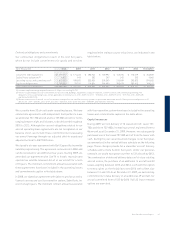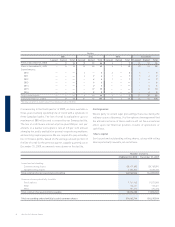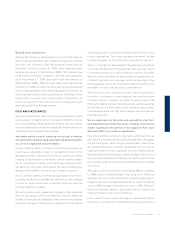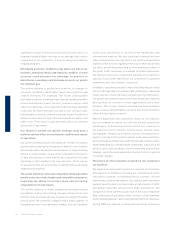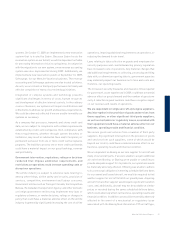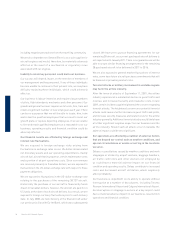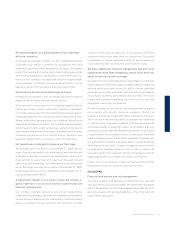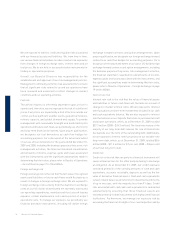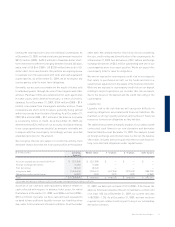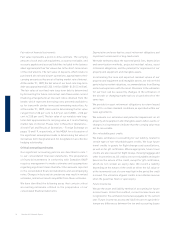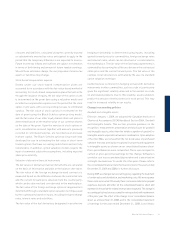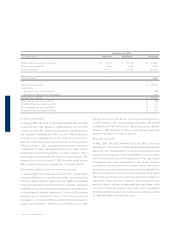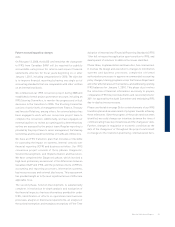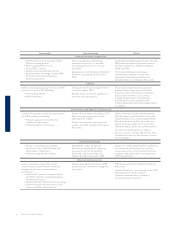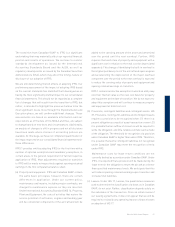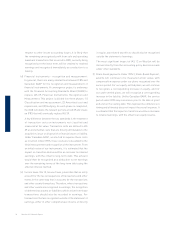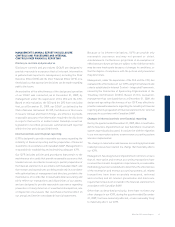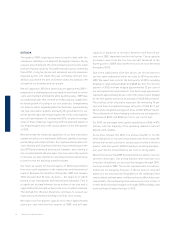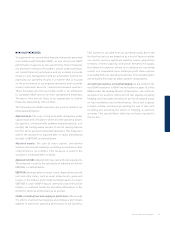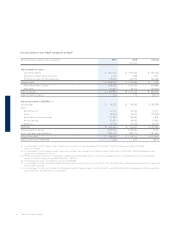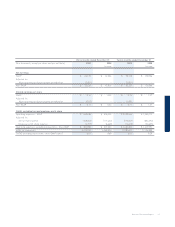Westjet 2009 Annual Report Download - page 63
Download and view the complete annual report
Please find page 63 of the 2009 Westjet annual report below. You can navigate through the pages in the report by either clicking on the pages listed below, or by using the keyword search tool below to find specific information within the annual report.
WestJet 2009 Annual Report 33
hedging relationship is determined using inputs, including
quoted forward prices for commodities, foreign exchange rates
and interest rates, which can be observed or corroborated in
the marketplace. The fair value of the fi xed swap agreements is
estimated by discounting the difference between the contractual
strike price and the current forward price. The fair value of the
costless collar structures is estimated by the use of a standard
option valuation technique.
Ineffectiveness is inherent in hedging jet fuel with derivative
instruments in other commodities, such as crude oil, particularly
given the signifi cant volatility observed in the market on crude
oil and related products. Due to this volatility, we are unable to
predict the amount of ineffectiveness for each period. This may
result in increased volatility in our results.
Change in accounting policies
Goodwill and intangible assets
Effective January 1, 2009, we adopted the Canadian Institute of
Chartered Accountants (CICA) Handbook Section 3064, Goodwill
and Intangible Assets. This section provides guidance on the
recognition, measurement, presentation and disclosure for goodwill
and intangible assets, other than the initial recognition of goodwill or
intangible assets acquired in a business combination. Upon adoption
of Section 3064, we reclassifi ed the net book value of purchased
software that was previously recognized in property and equipment
to intangible assets as shown on our consolidated balance sheet.
Prior-period balances were reclassifi ed. There was no impact to
current or prior-period net earnings for this change. Software is
carried at cost less accumulated depreciation and is amortized on
a straight-line basis over its useful life of fi ve years. Please refer to
the consolidated fi nancial statements and notes for the years ended
December 31, 2009 and 2008, for further disclosure.
During 2009, we changed our accounting policy regarding the treatment
of certain sales and distribution, and marketing costs. We now expense
these costs as incurred. Previously these costs were deferred in prepaid
expenses, deposits and other on the consolidated balance sheet and
expensed in the period the related revenue was recognized. The change in
accounting policy has been accounted for retrospectively with restatement
of the prior year. The effect of this change to our consolidated balance
sheet as at December 31, 2008, and to the consolidated statement
of earnings for the year ended December 31, 2008, is as follows:
of assets and liabilities, calculated using the currently enacted
or substantively enacted tax rates anticipated to apply in the
period that the temporary differences are expected to reverse.
Future income tax infl ows and outfl ows are subject to estimation
in terms of both timing and amount of future taxable earnings.
Should these estimates change, the carrying value of income tax
assets or liabilities may change.
Stock-based compensation expense
Grants under our stock-based compensation plans are
accounted for in accordance with the fair-value-based method of
accounting. For stock-based compensation plans that will settle
through the issuance of equity, the fair value of the option or unit
is determined on the grant date using a valuation model and
recorded as compensation expense over the period that the stock
option or unit vests, with a corresponding increase to contributed
surplus. The fair value of stock options is estimated on the
date of grant using the Black-Scholes option pricing model,
and the fair value of our other equity-based share unit plans is
determined based on the market value of our common shares
on the date of the grant. Upon the exercise of stock options or
units, consideration received, together with amounts previously
recorded in contributed surplus, are recorded as an increase
in share capital. The Black-Scholes option pricing model was
developed for use in estimating the fair value of short-term
traded options that have no vesting restrictions and are fully
transferable. In addition, option valuation models require the
input of somewhat subjective assumptions, including expected
share price volatility.
Valuation of derivative financial instruments
The fair values of derivative fi nancial instruments are calculated
on the basis of information available at the balance sheet date.
The fair value of the foreign exchange forward contracts is
measured based on the difference between the contracted rate
and the current forward price obtained from the counterparty,
which can be observed and corroborated in the marketplace.
The fair value of the foreign exchange option arrangements is
determined through a standard option valuation technique used
by the counterparty based on inputs, including foreign exchange
rates, interest rates and volatilities.
The fair value of the fuel derivatives designated in an effective


